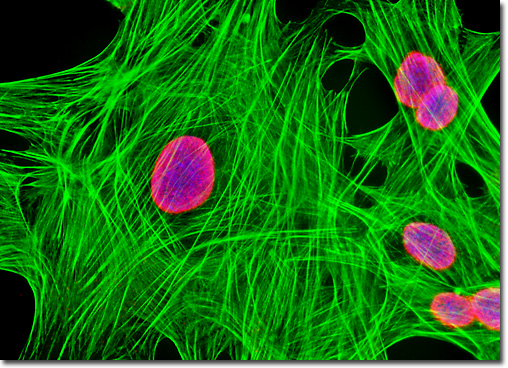Fluorescence Digital Image Gallery
Tahr Ovary Epithelial Cells (HJ1.Ov)
|
In eukaryotes, the nuclear envelope is comprised of two continuous concentric membranes that are differentiated by their protein compositions. In order to facilitate bidirectional traffic between the nucleus and the cytoplasm, a number of sophisticated structures known as nuclear pore complexes fenestrate the nuclear envelope. In mammalian cells, the complexes contain more than 50 different integral proteins (termed nucleoporins), and 3000 to 4000 of the complexes are typically present in a single nuclear envelope, though this number varies based upon how active the particular nucleus is in transcription. Exactly how a nuclear pore complex is built by nucleoporins is not yet fully understood, but several different substructures are assembled by the proteins, including columnar subunits that comprise the majority of the pore wall, annular subunits that extend spoke-like projections into the central pore region, luminal subunits that are involved in anchoring the complex to the envelope, and ring subunits that form the opposing faces of the complex. Also, fibrils extend outward from the cytosolic face of the nuclear pore complex and are arranged into basket-like formations on the nuclear side of the complex. The adherent culture of normal tahr ovary cells presented above was fixed, permeabilized, blocked with 10-percent normal goat serum, and treated with mouse anti-NPCP (nuclear pore complex protein) primary antibodies followed by goat anti-mouse secondary antibodies (IgG) conjugated to Alexa Fluor 568 (red fluorescence). Subsequently, the filamentous actin network and nuclear DNA were labeled with Alexa Fluor 488 conjugated to phalloidin and Hoechst 33258, respectively. Images were recorded in grayscale with a QImaging Retiga Fast-EXi camera system coupled to an Olympus BX-51 microscope equipped with bandpass emission fluorescence filter optical blocks provided by Omega Optical. During the processing stage, individual image channels were pseudocolored with RGB values corresponding to each of the fluorophore emission spectral profiles. |
© 1995-2025 by Michael W. Davidson and The Florida State University. All Rights Reserved. No images, graphics, software, scripts, or applets may be reproduced or used in any manner without permission from the copyright holders. Use of this website means you agree to all of the Legal Terms and Conditions set forth by the owners.
This website is maintained by our
|
